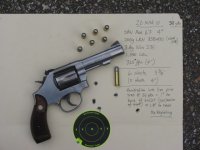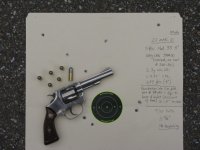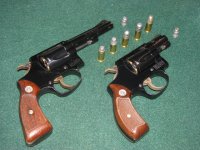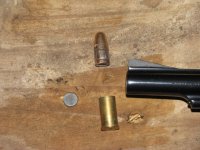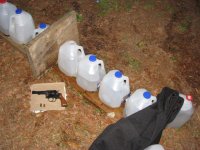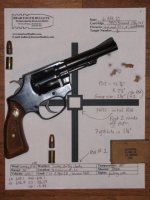LouisianaMan
Member
50-yd. 200g test against pine tree, 157g against milk jugs
1. 200g results @ long range
Attached photos of 50-yard target fired off of sandbags, prone, with the 358430 bullet in .38 S&W (vel. c. 630) from S&W Mod. 33. Bullet weight was 197-98g, cast .360 from 50-50 WW-Pb + tin. See also "better" target with .38 SPL @ 725fps, 192-93g, cast from straight WW, sized .358, fired from S&W Mod. 67.
I've plinked with autos at 75 yds before, but this is the first time I've fired a 50-yd. target with revolvers. Although my marksmanship is nothing to brag about, it would not have been fun to stand in front of the targets, especially since there was no keyholing at all. I presume the difference in accuracy was due primarily to better fit, sights, weight of M-67, esp. since Mod 33's sights are nickel--a bit of a strain in sunlight.
I presume the difference in accuracy was due primarily to better fit, sights, weight of M-67, esp. since Mod 33's sights are nickel--a bit of a strain in sunlight.
I also fired .38 SPL into a live pine tree at 56 yards and my probe touched the base of the slug 1" deep, so the nose of the bullet penetrated about 1.8" into the wood, plus 1/4 to 1/2" of bark.
When I fired the .38 S&W slug into a different live pine tree at 58 yards, my probe found the base 5/8" deep, so the nose penetrated about 1.5" into wood, plus 1/4 to 1/2" of bark.
So, the .38/200 supposedly bounced off of an overcoat???? I can't speak personally for the British 178g FMJ service round, but this 358430 is very similar to the original Brit lead bullet 200g load, and anyone expecting his overcoat to stop this bullet had better be wearing blue tights with a big "S" on his chest!
2. Water-filled milk jug penetration test with 150g LSWC
BULLET: Lyman Ideal 360231 LSWC, nominally 150g, but 157g as-cast with 50-50+tin, sized .361
LOAD: 2.5g Win231. COL = 1.086" Crimped in crimp groove.
REVOLVER: S&W Mod. 33, 4" bbl.
CHRONO: LO 694.6, HI 713.7, AVG 703.9, ES 19.08, SD 6.85
POI @ 60' approx. +2"
PENETRATION @ 10 FT." (with both 4" and 2" guns)
a. Mod 33, 4" bbl: Shot chrono'ed at 690.3 fps, drove straight line thru all 6 jugs, halfway-exited #6 and buried up to shoulder in 2x12 stop board. Note deformed bullet nose in photo.
b. Mod 32-1, 2" bbl" Shot chrono'ed at 581.2 fps. drove straight line thru 5 jugs, cracked hole barely in front of #6, and stuck horizontally between #5 and #6. Note undeformed bullet nose in photo.
PHOTOS:
#017: Mod 67 .38 SPL with 50-yd. target
#018: Mod 33 .38 S&W with 50-yd. target
#004: Mods. 33-1 and 32-1 used for water penetration test of 150g LSWC, with recovered bullets at respective muzzles. Other cartridges shown, with nominal bullet wts. (L-R): Lyman 360231 LSWC 150g; Lee LSWC-TL 158g; Lee GB of Lyman 358430 LRN 195g; flat-pointed Lee GB of Lyman 358430 LRN 195g; RCBS 35-200 LFP, 200g.
1. 200g results @ long range
Attached photos of 50-yard target fired off of sandbags, prone, with the 358430 bullet in .38 S&W (vel. c. 630) from S&W Mod. 33. Bullet weight was 197-98g, cast .360 from 50-50 WW-Pb + tin. See also "better" target with .38 SPL @ 725fps, 192-93g, cast from straight WW, sized .358, fired from S&W Mod. 67.
I've plinked with autos at 75 yds before, but this is the first time I've fired a 50-yd. target with revolvers. Although my marksmanship is nothing to brag about, it would not have been fun to stand in front of the targets, especially since there was no keyholing at all.
I also fired .38 SPL into a live pine tree at 56 yards and my probe touched the base of the slug 1" deep, so the nose of the bullet penetrated about 1.8" into the wood, plus 1/4 to 1/2" of bark.
When I fired the .38 S&W slug into a different live pine tree at 58 yards, my probe found the base 5/8" deep, so the nose penetrated about 1.5" into wood, plus 1/4 to 1/2" of bark.
So, the .38/200 supposedly bounced off of an overcoat???? I can't speak personally for the British 178g FMJ service round, but this 358430 is very similar to the original Brit lead bullet 200g load, and anyone expecting his overcoat to stop this bullet had better be wearing blue tights with a big "S" on his chest!
2. Water-filled milk jug penetration test with 150g LSWC
BULLET: Lyman Ideal 360231 LSWC, nominally 150g, but 157g as-cast with 50-50+tin, sized .361
LOAD: 2.5g Win231. COL = 1.086" Crimped in crimp groove.
REVOLVER: S&W Mod. 33, 4" bbl.
CHRONO: LO 694.6, HI 713.7, AVG 703.9, ES 19.08, SD 6.85
POI @ 60' approx. +2"
PENETRATION @ 10 FT." (with both 4" and 2" guns)
a. Mod 33, 4" bbl: Shot chrono'ed at 690.3 fps, drove straight line thru all 6 jugs, halfway-exited #6 and buried up to shoulder in 2x12 stop board. Note deformed bullet nose in photo.
b. Mod 32-1, 2" bbl" Shot chrono'ed at 581.2 fps. drove straight line thru 5 jugs, cracked hole barely in front of #6, and stuck horizontally between #5 and #6. Note undeformed bullet nose in photo.
PHOTOS:
#017: Mod 67 .38 SPL with 50-yd. target
#018: Mod 33 .38 S&W with 50-yd. target
#004: Mods. 33-1 and 32-1 used for water penetration test of 150g LSWC, with recovered bullets at respective muzzles. Other cartridges shown, with nominal bullet wts. (L-R): Lyman 360231 LSWC 150g; Lee LSWC-TL 158g; Lee GB of Lyman 358430 LRN 195g; flat-pointed Lee GB of Lyman 358430 LRN 195g; RCBS 35-200 LFP, 200g.

